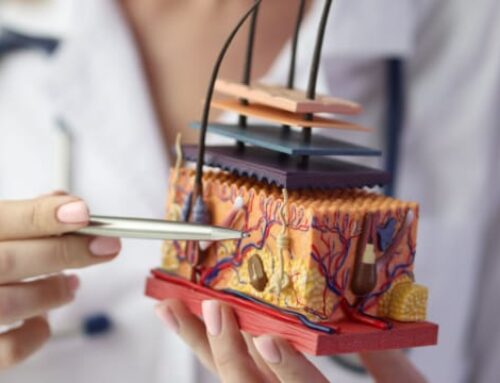Flashback to 1997: Bill Clinton was President, R. Kelly was singing “I Believe I Can Fly”, and chemical peels were the number-one cosmetic procedure in the country. The popularity of chemical peels began to decline in the early 2000s, however, as brand new cosmetic procedures, such as laser rejuvenation treatments, hit the market.
Just like 90s chokers have made a reappearance, chemical peels are back on top in 2017. In fact, people are getting them now more than ever, according to the American Society for Aesthetic Plastic Surgery. And they’re popular for good reason: chemical peels are a safe, effective, and relatively inexpensive method for treating various skin disorders and to refresh and rejuvenate skin. Keep reading to learn about the different types of peels and how a chemical peel can improve your complexion.
What is a chemical peel?
Chemical peeling is the process of applying chemicals to the skin to create a controlled form of injury: the chemicals destroy the outer damaged layers to a specific skin depth. The goal is to stimulate new epidermal growth and collagen production while improving surface texture and appearance. (J Clin Aesthet Dermatol. 2010)
Chemical peels can be used for the reversal of signs of skin aging and for the treatment of skin lesions as well as scars, particularly acne scars. Dyschromias, wrinkles, and acne scars are the major clinical indications for facial chemical peeling. (Clinics in Dermatology, 2008)
David Bank, an assistant clinical professor of dermatology at Columbia University/Presbyterian Hospital in New York City, gives Allure a basic overview of how chemical peels work to rejuvenate the skin, “As that topmost layer is shed, signals are sent to the living cells below to multiply and move up, to increase collagen production, to make more hyaluronic acid—to act younger.”

What are the different types of chemical peels?
Chemical peels are classified by the depth of action into superficial, medium, and deep peels.
Superficial peels affect the epidermis and dermal-epidermal interface. Available agents for superficial peels include the following:
- Alpha hydroxy acids (AHAs) such as glycolic acid (GA)
- Beta hydroxy acids (BHAs) such as salicylic acid (SA)
- Tretinoin
- 10 to 20% Trichloroacetic acid (TCA)
Medium-depth peels reach deeper layers than superficial peels, but aren’t as aggressive as deep peels, and typically involve combination peels. For example:
- 35% Trichloroacetic acid (TCA)
- Monheit’s combination (Jessner’s solution with TCA)
- Brody’s combination (solid carbon dioxide with TCA)
- Coleman’s combination (GA 70% + TCA)
- Jessner’s solution with GA
Deep chemical peels penetrate the reticular dermis and may be used for severe photoaging, deep or coarse wrinkles, scars, and sometimes precancerous skin lesions. (J Clin Aesthet Dermatol. 2010) Deep chemical peels use very strong chemicals, including phenol and croton oil, which rapidly denature surface keratin and other proteins in the dermis. Since these peels penetrate so deeply they maximize the generation of new collagen. According to the American Society of Plastic Surgeons, this type of peel may require a local anesthetic and a sedative to manage any discomfort. Additionally, the healing time after a deep peel is much longer than other peels, ranging anywhere from two weeks to two months. Currently, new laser techniques are a popular alternative for major deep skin resurfacing because they avoid the adverse effects of deep chemical peels and don’t require such a long recovery time.

What are the most popular chemical peels?
While there are many chemical peels on the market, three of the most popular peels are the Illuminize Peel®, the Vitalize Peel®, and the Rejuvenize Peel™.
The Illuminize Peel® is an excellent option for mild skin imperfections, first-time chemical peel patients, or those looking for a gentle, non-invasive solution to a dull, lackluster complexion. This chemical peel treatment gently removes the top layer of dead skin cells and other debris to allow for more efficient penetration of your topical skin care products while leaving your skin with a beautiful, radiant glow.
The Vitalize Peel® is a popular cosmetic treatment that can address a wide range of skin concerns, including hyperpigmentation, acne scarring, sun damage, and lines and wrinkles. It contains a blend of alpha- and beta-hydroxy acids, as well as resorcinol and retinoic acid, to impart a smooth radiance and even skin tone and texture.
Rejuvenate your skin with the Rejuvenize Peel™, which helps to smooth away the appearance of fine lines and wrinkles. While most people see noticeable results after just one treatment, a combination of 3 to 6 peels typically produces ideal results.
Board-certified dermatologist Dr. Jessica Krant offers all three of these popular chemical peels in her Manhattan based office, the Art of Dermatology, as well as many additional cosmetic treatments that can help you to achieve the look and feel you desire. Schedule a consultation to see if a chemical peel is the best treatment option for you.














Leave A Comment